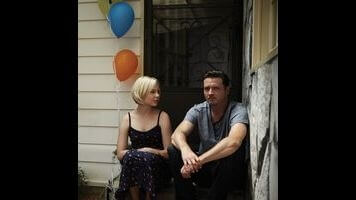The most acclaimed aspect of the show’s roundly acclaimed first season was Aden Young’s performance as Daniel Holden, the former convict at the show’s center. Young’s performance suggested deep wells of sensitivity and empathy at Daniel’s core. But there’s also a hint of something more tortured as to indicate he really could have raped and murdered his high-school girlfriend. The show carefully built to moments when Daniel would marvel at department stores or hot dog cookers, but offered deeper content to convey just how much his time in prison changed and marked him. Though Rectify was filled with great characters—and an amazing cast playing them—it was decidedly Young’s show.
Naturally enough, the second season begins with two episodes that barely feature him.
Some of this stems from plot. (Daniel ended last season in no position to start this season as the show’s putative hero.) A little stems from the show’s other characters now being well-developed enough to shoulder the load for a couple of episodes. (In particular, the first few episodes lean heavily on Abigail Spencer as Daniel’s sister, Amantha, and J. Smith-Cameron as his mother, Janet.) But most of it stems from creator and showrunner Ray McKinnon’s complete and utter confidence in the series’ slow-moving storytelling and careful peeling back of the characters’ layers. Season one was set over a long, drowsy summer week, when life is full and abundant, but also a little sleepy. Season two is set in the fall, a chill wind in the air and the suggestion of disaster just around the corner. (Strangely, only a few days seem to have passed, but this is in keeping with the show’s slightly ethereal nature.) The scripts and direction of the season’s first three episodes reflect that as well. If the first season was about the wonder of unlikely survival, the second is about practicality—about what it means to actually resume one’s life after a lengthy pause.
Rectify sets itself apart from other TV shows through its use of a specific shot: an overhead view that suggests God looking down on his creation. The series does beautiful things with this camera angle, particularly in its occasional flashbacks to Daniel’s time on death row, keeping an eye on the goings-on in two side-by-side cells as if the characters were avatars in a computer game. The suggestion of a deity passively watching its creation go through any given day is fitting for the series, which evinces a kind of old-school Christianity. It’s not quite fire and brimstone, but it’s in the same neighborhood. There are few TV shows as concerned with grace as Rectify is—but there are also few shows as concerned with sin. Biblical allusions arrive frequently (in the first season, Daniel even wrestled with a man who may or may not have been a proxy for the almighty), and it also features one deeply Christian character (Adelaide Clemens’ pitch-perfect Tawney) who is treated with dignity and seriousness. Some of the best material focuses on her marriage to Clayne Crawford’s Teddy, who gets major character rehabilitation in the early going here.
If there’s one Christian concept that Rectify has most glommed onto, however, it’s the notion of salvation. And the show is interested in this concept beyond the notion of Christ dying for anyone’s sins. It’s particularly insistent on the notion that salvation does not particularly care if a person was good or bad, prior to accepting it—and this extends to how human beings treat each other as well. All the characters run into people who don’t like them or even mean them harm, but Rectify is always looking toward the reasons anyone might extend mercy. The people on this show strive to do the right thing, even if they don’t know what that is all of the time, and that is what sets them apart.
Yet the series wouldn’t work without the tension between this mercy and the potential for its opposite. In one of the season’s less successful subplots—but one that seems like an important indicator of what Rectify is up to this year—Luke Kirby’s Jon, the lawyer who got Daniel’s case reopened and vacated, visits with another death-row inmate who successfully hoodwinked him into thinking he didn’t commit any crimes. It’s this notion of pretending, of wearing a human mask over something monstrous, that troubles Rectify down at its heart.
Maybe God really is looking down on all of us. But if we appear to him as toys wandering through elaborate dollhouses, perhaps he knows even less than we do about humanity’s potential for good and evil. Indeed, the series all but comes out and says this in the final scene of the season premiere—one of the most beautiful sequences to be seen on television in this or any year. In it, Daniel confronts that in-between state, that tension between good and evil, life and death, love and hate. It could all feel very perfunctory, but in the hands of McKinnon and company, it feels revelatory. God might exist, but he’s left us all wandering in the woods, desperate to find our own paths.









































